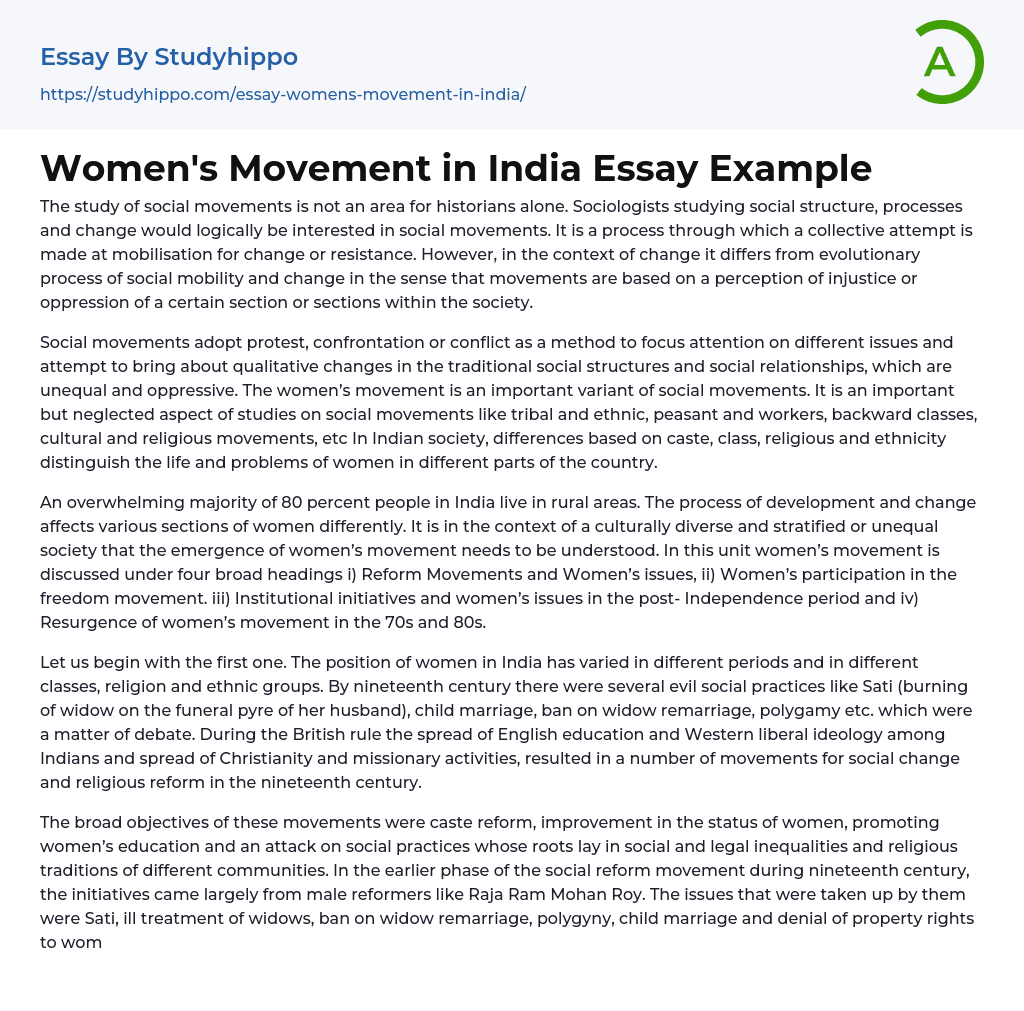The study of social movements is not an area for historians alone. Sociologists studying social structure, processes and change would logically be interested in social movements. It is a process through which a collective attempt is made at mobilisation for change or resistance. However, in the context of change it differs from evolutionary process of social mobility and change in the sense that movements are based on a perception of injustice or oppression of a certain section or sections within the society.
Social movements adopt protest, confrontation or conflict as a method to focus attention on different issues and attempt to bring about qualitative changes in the traditional social structures and social relationships, which are unequal and oppressive. The women’s movement is an important variant of social movements. It is an important but neglected a
...spect of studies on social movements like tribal and ethnic, peasant and workers, backward classes, cultural and religious movements, etc In Indian society, differences based on caste, class, religious and ethnicity distinguish the life and problems of women in different parts of the country.
An overwhelming majority of 80 percent people in India live in rural areas. The process of development and change affects various sections of women differently. It is in the context of a culturally diverse and stratified or unequal society that the emergence of women’s movement needs to be understood. In this unit women’s movement is discussed under four broad headings i) Reform Movements and Women’s issues, ii) Women’s participation in the freedom movement. iii) Institutional initiatives and women’s issues in the post- Independence period and iv) Resurgence of women’s movement in the 70s
and 80s.
Let us begin with the first one. The position of women in India has varied in different periods and in different classes, religion and ethnic groups. By nineteenth century there were several evil social practices like Sati (burning of widow on the funeral pyre of her husband), child marriage, ban on widow remarriage, polygamy etc. which were a matter of debate. During the British rule the spread of English education and Western liberal ideology among Indians and spread of Christianity and missionary activities, resulted in a number of movements for social change and religious reform in the nineteenth century.
The broad objectives of these movements were caste reform, improvement in the status of women, promoting women’s education and an attack on social practices whose roots lay in social and legal inequalities and religious traditions of different communities. In the earlier phase of the social reform movement during nineteenth century, the initiatives came largely from male reformers like Raja Ram Mohan Roy. The issues that were taken up by them were Sati, ill treatment of widows, ban on widow remarriage, polygyny, child marriage and denial of property rights to women and the need to educate women.
Struggle for women’s education initiated by men resulted in setting up of women’s schools, colleges, hostels, widow homes, protection homes etc. The social reformers’ assumptions were that female education would revitalise the family system, which was threatened by the increasing communication gap between educated men and their uneducated wives. The social reform movement saw the emergence of women’s organisations and institutions. However, the movement was led by men and originated in metropolitan cities. Leaders of
the social reform movement also realised that religious reforms cannot be separated from it.
The British policy was to keep different religious communities separate from each other and maintain each system of family laws, which was closely related to the religious and customary traditions of each community. Social reform movement never developed as a unified movement but developed within each community. This period has witnessed the proliferation of various organisations. These Women’s and Movement organisations took the lead to project important issues, which adversely affected the status of women in the society. The most important of these organisations where the Brahmo Samaj, Prarthana Samaj, Arya Samaj.
- Montgomery Bus Boycott essays
- Urbanization essays
- Civil Disobedience essays
- Protest essays
- Bangladesh essays
- China essays
- Hong Kong essays
- India essays
- Japan essays
- Kuala Lumpur essays
- Malaysia essays
- Manila essays
- Pakistan essays
- Philippines essays
- Singapore essays
- Vietnam essays
- Vietnamese essays
- Adoption essays
- Aunt essays
- Babies essays
- Bedroom essays
- Caring essays
- Children essays
- Daughter essays
- Divorce essays
- Dog essays
- Dysfunctional Family essays
- Family Tradition essays
- Family Values essays
- Father essays
- Foster Care essays
- Friends essays
- Grandparent essays
- Home essays
- Hometown essays
- Husband essays
- Jealousy essays
- Love essays
- Marriage essays
- Mother essays
- Online Dating essays
- Parenting essays
- Parenting Teens essays
- Parents essays
- Relationship essays
- Room essays
- Sibling essays
- Sister essays
- Wedding essays
- Wife essays




